BitMEX founder: Inflation has become the new normal in the world, I am cautiously bullish on Bitcoin
This article comes frombitmex, Original Author: Arthur Hayes, Co-Founder, BitMEX
Odaily Translator |
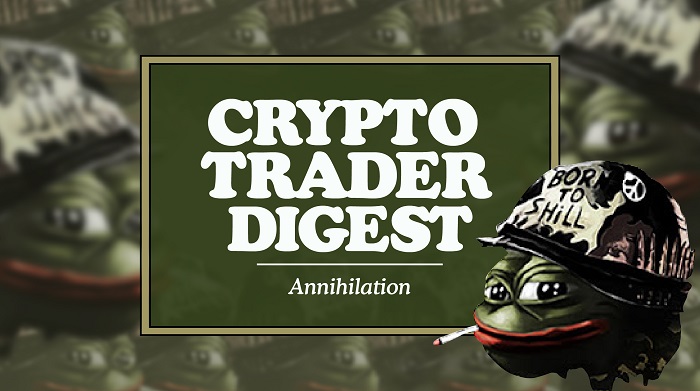
Odaily Translator |
From a macro-humanist perspective, war is always destructive and energy-intensive.
Human civilization converts the potential energy of the sun and the earth into food, shelter and entertainment, and war is an act of consuming energy to destroy the achievements of human civilization. While one side "wins" and achieves some sort of resource-driven goal by defeating the enemy, the humans lose.
So now, our biggest waste may be currency, and the most obvious impact of this is inflation. We must be prepared to protect the value of our financial assets.
secondary title
See the truth from behind
Against the backdrop of the world's most accommodative monetary policies ever, there have also been recent frightening clashes between countries. I know that the central banks of every country are trying their best to deal with inflation and promise to solve it properly, but the central banks of almost every country are still printing money. Looking at some charts of policy rates versus official inflation measures, we found that, in fact, the “official” inflation measures are not at all representative of the prices faced by ordinary citizens. I believe that these statistics are processed and embellished, when in fact consumer price inflation has deteriorated so badly that even the official figures are a mess.
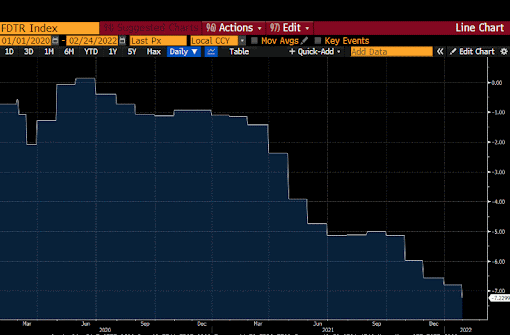
US Fed Funds – US CPI = US real interest rate (currently -7%)
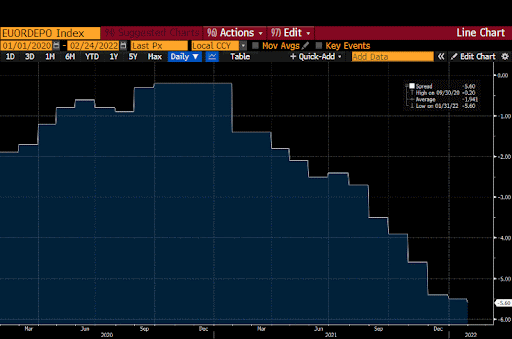
Eurozone deposit rate – Eurozone CPI = Eurozone real interest rate (currently -5%)
Bank of England Rate – UK CPI = UK Real Interest Rate (currently negative 5%)
The three charts above show [Policy Rate - Official Consumer Price Inflation Index]. As you can see, real interest rates have gone pretty negative since the pandemic hit. Imagine if you have 1 dollar in your wallet, or 1 euro, 1 pound, and next year, the value of these fiat currencies suddenly drops by 5% to 7%. It would be fine if workers’ wages had risen accordingly, but for most wage earners or hourly workers, wages have not risen as the currency in their physical or digital wallets depreciates.
As you can feel, ordinary people are very dissatisfied that their wages have not kept up with the increase in the price of food, energy and transportation. What politicians are doing now is getting their "independent" central bank to keep inflation in check. There is no dispute that central banks must raise policy rates; however, there is debate about how much they raise rates and how quickly they do so.
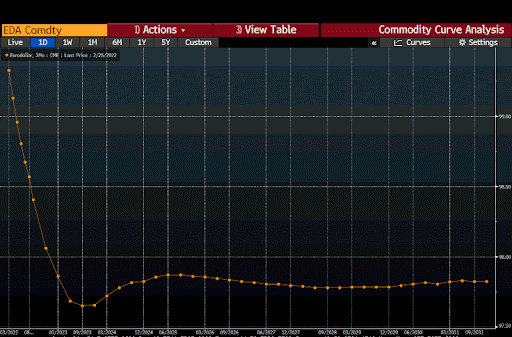
If the Fed raises interest rates six times this year, the entire financial world will certainly present a picture of the end of the world. In fact, the U.S. federal funds futures market has long predicted the outcome of interest rate hikes. They assume that the Fed raises interest rates by 0.25 percentage points each time, and eventually the so-called "policy rate" will be pushed up to 1.5%. We know that the current CPI inflation rate in the United States has soared above 7%. In this case, even if the inflation rate is halved to 3.5% by the end of 2022, the real interest rate of the US dollar will still be negative 2%.
The picture above shows the term structure of Eurodollar futures. To get the rate of return on US dollar deposits held outside the United States, use 100 and subtract the futures price. For example, if the Eurodollar futures price is 98.00, the yield is 2%. ,
I have a lot to say about the importance of the Eurodollar market, but it boils down to one: it is the most important interest rate market in the world and is heavily influenced by Fed policy.
If we look at the trend line, Eurodollar futures will peak at close to 2.5% next September because the market expects the Fed to raise short-term interest rates, so these futures are all reflecting three-month dollar deposits interest rate. It can be said that 2.5% is not enough to fight the current inflation level, and this has not taken into account the medium and large war factors that will affect global energy use in the next year.
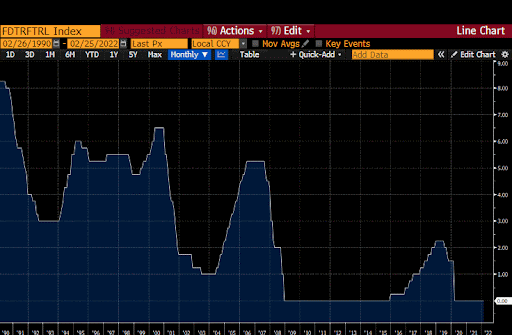
Although American politicians ordered to "repair inflation", the final implementation effect was not satisfactory. Why is this? Because the level of policy interest rates that could lead to a financial crisis gets lower and lower with each recession.
The chart above is a graph of the lower bound for the federal funds rate since 1990. We find that every major global financial crisis has been triggered by the accumulation of leverage and debt in certain areas of financial markets. Once the Fed raises interest rates, the bubble will be burst, because blind financing will make speculators pay a higher price.
After the first Gulf War with Iraq, the Fed ended the era of low interest rates, raising rates by about 5% to 6% in late 1994. However, this led to the Mexican peso crisis, which ended with the intervention of the US Treasury and a slight reduction in interest rates by the Federal Reserve. A few years later, however, when interest rates rose to nearly 6%, the Asian financial crisis erupted. Due to the increase in the cost of US dollar funds, the "Asian Tigers" have asked the International Monetary Fund and the World Bank for economic assistance.
We all know what happened in the tech industry in 2000. The chart clearly shows that the Fed lowered interest rates slightly after the Asian financial crisis and then raised them again. The rising cost of capital put an end to the hopes and dreams of a technological utopia, and with it came an unexpected stock market crash.
6 percent, then 5 percent, then 2 percent—almost every decade, financial markets see lower nominal interest rates. Given the explosion of systemic debt and leverage around the world in the wake of COVID-19 due to low or negative interest rates and the need to generate yields, I don't think global financial markets can afford even 2% dollar nominal interest rates. A look at the chart above shows that at a policy rate of 2%, rates are still negative. Unless workers start getting bigger raises, they will still suffer from inflation month after month. So, let's talk about-
secondary title
inflation narrative
Every asset class has a changing narrative, but one key metric for judging an asset’s value is whether it’s a good hedge against inflation. Many people instinctively believe that, as a scarce asset, Bitcoin and other cryptocurrencies should be good inflation hedges. This idea may have been true for many years, but recently Bitcoin's performance seems to be more "risk-on" than "safe-off". It seems that when the market is lower, Bitcoin has not become an appreciation as expected. assets.
Frankly speaking, the reason why the price of Bitcoin has been able to rise sharply is largely due to the fact that the central banks of many countries have begun to print a large number of money and issue more currency due to the new crown virus epidemic. In other words, Bitcoin needs to "digest" this sharp rise in a short period of time. Once the liquidity starts to tighten, Bitcoin's performance may not be as good as you expected.

However, let's put aside the issue of negative interest rates and look at how the macro economy has affected Bitcoin's performance in the past from a historical perspective. In March 2020, the price of Bitcoin was around $4,500, but by November 2021, the price of Bitcoin had soared to nearly $70,000. Then the central banks changed their tune - they started doing the right thing to curb inflation, the market reacted quickly and the crypto bull market stalled.
The chart above shows Bitcoin (yellow line) compared to the US 2-year Treasury note (white line) since September 2021. In my opinion, the reason for Hu Zhengyao, who has stagnated the Bitcoin bull market, is because of the tightening of global liquidity. In anticipation of future increases in nominal interest rates by central banks in many countries (such as the Federal Reserve), the market began to re-price fiat currency credit, resulting in an 8-fold increase in US 2-year Treasury yields - while on the other hand, Bitcoin The price traded sideways and started to move slightly lower.
At this time, gold finally began to slowly come out of the trough. Gold is starting to move higher towards $2,000 as U.S. interest rates remain in negative territory. Furthermore, the price of gold has continued to rise despite rising short-term nominal U.S. interest rates because U.S. real interest rates remain negative. Finally, in the face of the devaluation of fiat currencies, gold's value-preserving properties came into play and regained the attention of investors. I expect bitcoin to eventually experience a similar narrative to gold, with investors rediscovering the value of bitcoin. The most important thing for investors, though, is to be patient and tame your itchy fingers and not hit the buy button randomly so that you can re-enter or reallocate financial market assets when the time comes.
What might happen if the current situation in Eastern Europe expands further and turns into a medium or large global conflict? Let us first analyze the current market environment:
1. Due to environmental issues, many countries have decided to reduce investment in hydrocarbon production and exploration, which will result in society replacing cheap hydrocarbons with relatively expensive wind and solar energy (measured according to the energy generated by each and the energy investment required for each ). As a result, people have to pay more for everything because, as a human being, it takes energy to survive within the current social structure. One could argue that the cost of hydrocarbons doesn't fully reflect their negative environmental externalities - but when a family has to pay 50% more to heat their home during harsh winters, all problems come to the fore.
2. In the past 50 years, countries around the world have printed the largest amount of money in human history. On the other hand, aging populations in all major economies mean that the ability to service debt will become less and less. To keep the game going, central banks must keep printing money so they can “pay old debts with new money”. Taking the United States as an example, the U.S. government will not voluntarily allow its own currency to default, so even if there is large-scale inflation, it will not hesitate.
3. After the new crown virus epidemic, inflation rates in many countries have risen, and labor has become scarcer. In today's "post-epidemic era", global costs are rising because fewer and fewer workers are still on the production line, so they will demand higher wages and benefits. Robots are not ready yet, so companies Workers are still needed.
Back to the currency issue, what do central bankers do when politicians who demand the Fed to rein in inflation wield their knives? I think there are three possibilities:
secondary title
Scenario 1: Curbing Inflation
To properly control inflation, the central bank would have to get the dollar to at least 0% real interest rates, which would imply that the policy rate would need to be above 6% - which seems unlikely given the current state of financial markets, but it is One figure is the minimum necessary interest rate level necessary to curb inflation and correct all imbalances of the past 50 years.
It should be noted that the current sharp rise in energy prices (oil prices) is largely due to non-currency, and the central bank may not be able to do anything about it, so it may raise interest rates, raise interest rates, and raise interest rates, while energy prices will never fall, and then once With the global economy collapsing, energy demand per capita would drop significantly, because we have drastically reduced our consumption patterns—that is, there could be a sudden plunge in energy prices.
But I think that's unlikely to happen.
secondary title
Scenario 2: Misleading the market
We could easily be misled by the market for most of 2022.
In a lot of the financial media, you see central bankers showing up and telling politicians that they are serious about fighting inflation. Bankers raised the policy rate to a range of 1% to 2% - because the futures market told them they needed to, and that was it. But even then, real interest rates on the dollar are still negative, which is very important in times of war or near war, why? Because governments need money to fight wars or prepare for wars, and they need to pay for wars.
By keeping real interest rates negative while ensuring nominal government bond rates are below nominal GDP growth, the U.S. government can afford to finance and reduce its debt/GDP ratio. Sneaky transfer of wealth. While this level of nominal policy interest rates would result in a recession, it would not significantly alter the social fabric, and the U.S. government could still afford war financing.
The problem here, however, is that the Fed has no control over energy costs, which are likely to continue to get more expensive. And, since the Federal Reserve's monetary policy remains loose on government spending, the U.S. government will still crowd out private companies in energy use, which means energy costs will continue to rise, and ultimately, a lack of anti-inflation beliefs could lead to social unrest.
U.S. interest rates are closely related to our portfolio, but first, patience.
If the Fed and other central banks raise interest rates, asset prices will be depressed, and the first escape from the "carnage" at this time will be Bitcoin and cryptocurrencies, because the crypto market is the only freely traded market, all Any human with an internet connection can participate. Therefore, compared to other TradFi markets, the crypto market will first fall and then rise. Keep in mind that our analysis is based on the assumption that real interest rates will remain negative, and that scarce assets will undoubtedly benefit once persistent negative real interest rates erode the purchasing power of fiat currencies.
The U.S. government doesn’t want to restructure society by raising interest rates to really dampen consumer demand and government spending. After all, once the election is over, the political pressure to fight inflation will disappear.
Again, for crypto traders, patience is required.
If you are already in the benchmark crypto assets (mine are Bitcoin and Ethereum), please don't sell casually, don't go short. At this point you can open a bottle of wine, or read a book (don't use TikTok), and then calm down. If you are a dedicated trader who buys and sells cryptocurrencies on a daily basis, then remember that market declines may be short-lived compared to the narrative of an inflation-proof asset, so don’t get greedy – get in, get out, and see the long-term.
(Note: This article was written over the weekend when it appeared that the Russia-Ukraine conflict would be short-lived and the West’s reaction was calm. However, the war continued and the West seemed prepared to endure economic pain to decouple from Russia. Note that Russia is a major supplier of food and energy, and losing these supplies to global markets would lead to high inflation. Also, if the West does decouple from Russia, there's no real way to know exactly what the consequences will be. As you find out You never know where the problems on the balance sheets of financial institutions are hiding until the market moves. Therefore, it is reasonable to assume that once the decoupling of the West and Russia will lead to financial difficulties for some large financial institutions, this situation may turn into one. a global financial crisis.
But the West's political reaction to Russia presents an opportunity for global central banks to drop their commitment to fighting inflation. I'm not sure they'll actually be able to do that, so I'm cautiously bullish on Bitcoin. I'm trying to invest in some bitcoin and ethereum call options.
To be clear, rising oil prices are still going to happen, and I'm not ready to invest in more cryptocurrencies, and you have to be very cautious about buying any asset in the face of changing market conditions. If the Fed deviates from market expectations and raises interest rates by 0.25% to 0.50% in mid-March, financial leverage can cause cryptocurrencies to fall again. )
secondary title
Scenario 3: The U.S. dollar printing machine accelerates to open
A fierce global conflict will completely change the rules of the game, and perhaps the opportunity to print money in dollars will accelerate.
Price controls, rationing, and inflation will be the new normal for nations as this is the only way to provide all available resources to the military. Gold, Bitcoin, and other cryptocurrencies will be hoarded more and more, and this is actually where Gresham's Law comes into play.
(Odaily Jun Note: Gresham’s Law is an economic law, also known as the law of bad money driving out good money, which means that in the case of a dual-standard currency system, when two currencies are in circulation at the same time, if one of them depreciates, its actual value Relatively lower than the value of another currency, the "good currency" whose actual value is higher than the legal value will be generally collected, gradually disappear from the market, and finally expelled from the field of circulation, and the "bad currency" whose actual value is lower than the legal value ” will flood the market.)
In this case, it will become more difficult to enter the gold and crypto markets, because some capital control policies will appear, so that many ordinary citizens cannot protect their assets and end up having to be "looted" by inflation.
In effect, most fiat-denominated financial assets will become worthless, perhaps as worthless as toilet paper. Yes, in nominal terms, your stock portfolio may go up, but the price of milk, butter, eggs, sugar, etc. will go up faster than your free stock index fund.
I really don't want this to happen. But unfortunately, the history of humanity is a history of conflict.
If you think something bad is likely to happen, plan ahead and plan for it.
secondary title
Summarize
Summarize
Everyone now has a smartphone in their pocket, a mass communication tool for sharing knowledge instantly. However, while we can all remain idealistic and hope that the proliferation of information will change the human propensity to wage war, we must be prepared not to let our fortunes be ravaged by inflation.
Of course, this is not to say that we should ignore short-term price movements, but in general, it is possible to take a long-term view and then grasp the timing of buying assets and selling assets.



